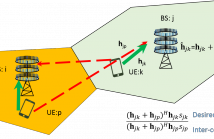
- Read more about Rate-Splitting for Multi-Antenna Non-Orthogonal Unicast and Multicast Transmission
- Log in to post comments
In a superimposed unicast and multicast transmission system, one layer of Successive Interference Cancellation (SIC) is required at each receiver to remove the multicast stream before decoding the unicast stream. In this paper, we show that a linearly-precoded Rate-Splitting (RS) strategy at the transmitter can efficiently exploit this existing SIC receiver architecture.
- Categories:
 12 Views
12 Views
- Read more about Symbol-Level Precoding Design for Max-Min SINR in Multiuser MISO Broadcast Channels
- Log in to post comments
In this paper, we address the symbol level precoding (SLP) design problem under max-min SINR criterion in the downlink of multiuser multiple-input single-output (MISO) channels. First, we show that the distance preserving constructive interference regions (DPCIR) are always polyhedral angles (shifted pointed cones) for any given constellation point with unbounded decision region. Then we prove that any signal in a given unbounded DPCIR has a norm larger than the norm of the corresponding vertex if and only if the convex hull of the constellation contains the origin.
- Categories:
 22 Views
22 Views
- Categories:
 26 Views
26 Views
- Read more about Can Hardware Distortion Correlation be Neglected When Analyzing Uplink SE in Massive MIMO?
- Log in to post comments
This paper analyzes how the distortion created by hardware impairments in a multiple-antenna base station affects the uplink spectral efficiency (SE), with focus on Massive MIMO. The distortion is correlated across the antennas, but has been often approximated as uncorrelated to facilitate (tractable) SE analysis. To determine when this approximation is accurate, basic properties of the distortion correlation are first uncovered.
- Categories:
 13 Views
13 Views
- Read more about Pilot Contamination in Massive MIMO: A Measurement-based Analysis using 2D-MUSIC
- Log in to post comments
When a base station (BS) sees desired and interfering
users at different angles, it results in non-overlapping angleof-
arrival (AoA) regions for those users. This is important for
reducing pilot contamination (PC) of massive MIMO systems.
Most state of the art studies utilize a simple non-line-of-sight
(NLoS) one-ring model which assumes sparse support and can
reasonably schedule users with different AoA to minimize PC.
However, it is not confirmed with measurements that the one-ring
- Categories:
 32 Views
32 Views
- Read more about PERFORMANCE OF INTERLEAVED TRAINING FOR SINGLE-USER HYBRID MASSIVE ANTENNA DOWNLINK
- Log in to post comments
In this paper, we study the beam-based training design for the single-user (SU) hybrid massive antenna system based on outage probability performance. First, an interleaved training design is proposed where the feedback is concatenated with the training procedure to monitor the training status and to have the training length adaptive to the channel realization. Then, the average training length and outage probability are derived for the proposed interleaved training and SU transmission.
- Categories:
 14 Views
14 Views- Read more about PARALLEL BEAMFORMING DESIGN IN FULL DUPLEX SYSTEMS WITH PER-ANTENNA POWER CONSTRAINTS
- Log in to post comments
We investigate the max-min weighted downlink signal-to-interference ratio (SINR) problem under uplink SINR
constraints and practical per-antenna constraints in full-duplex systems. The successive convex approximation (SCA)
- Categories:
 3 Views
3 Views
- Read more about FDD Channel Spatial Covariance Conversion Using Projection Methods
- Log in to post comments
Knowledge of second-order statistics of channels (e.g. in the form of covariance matrices) is crucial for the acquisition of downlink channel state information (CSI) in massive MIMO systems operating in the frequency division duplexing (FDD) mode. Current MIMO systems usually obtain downlink covariance information via feedback of the estimated covariance matrix from the user equipment (UE), but in the massive MIMO regime this approach is infeasible because of the unacceptably high training overhead.
- Categories:
 15 Views
15 Views
- Read more about Semi-blind Channel Estimation in Massive MIMO Systems with Different Priors on Data Symbols
- Log in to post comments
This paper investigates semi-blind channel estimation in massive multiple-input multiple-output (MIMO) systems using different priors on data symbols. We derive two tractable expectation-maximization (EM) based channel estimation algorithms; one based on a Gaussian prior and the other one based on a Gaussian mixture model (GMM) for the unknown data symbols. The numerical results show that the semi-blind estimation schemes provide better channel estimates compared with the estimation based on training sequences only.
- Categories:
 60 Views
60 Views
- Read more about A Refined Analysis of the Gap between Expected Rate for Partial CSIT and the Massive MIMO Rate Limit
- Log in to post comments
Optimal BeamFormers (BFs) that maximize the Weighted Sum Rate
(WSR) for a Multiple-Input Multiple-Output (MIMO) interference
broadcast channel (IBC) remains an important research area. Under
practical scenarios, the problem is compounded by the fact that only
partial channel state information at the transmitter (CSIT) is available.
Hence, a typical choice of the optimization metric is the Expected
Weighted Sum Rate (EWSR). However, the presence of the
expectation operator makes the optimization a daunting task. On the
- Categories:
 Views
Views